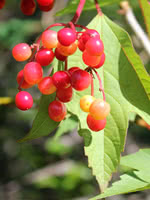Mon-Fri 9am - 5pm Mountain time
Highbush Cranberry vs Black Elderberry
Sambucus canadensis
Viburnum opulus var. americanum (trilobum)
NOT AVAILABLE THIS SEASON - MIGHT RETURN
Black Elderberry is a deciduous shrub native to eastern North America. You can plant this shrub in moist areas and it will help stabilize your soil. You can also use it on rural properties anywhere you'd use a lilac.
Black Elderberries are considered to be partially self-pollinating. So while they will still produce some berries without cross-pollination, planting with another variety will increase yields. Consider planting with Ranch Elderberry or Bob Gordon Elderberry.
Warning: the seeds, stems, leaves, roots, and uncooked berries of the Black Elderberry are poisonous to humans when eaten in quantity. You should cook the berries to make them safe for human consumption.
Highbush Cranberry produces attractive white flowers in late June and bears edible fruit that matures to a bright red colour in the late summer.
This shrub, native to much of Canada, is fast growing, and its fruit can be eaten raw or cooked into a sauce.
Black Elderberry Quick Facts
Highbush Cranberry Quick Facts
Toxicity: leaves, stems, and uncooked berries are poisonous to humans
In row spacing: 0.6 m (2.0 ft)

